There are numerous ways and means of incorporating date and calendar displays on a timepiece, ranging from the date alone, the day, and calendar complications with varying degrees of complexity. In this article we will look at what different manifestations of date displays there are, and explore the differences between complete calendar, annual calendar and, of course, the perpetual calendar complications.
Watch Date Displays
Whilst calendar complications and date displays can be found in pocket watches dating from the last 1800s, the first application of such a complication in a wristwatch did not appear until later. The first patents for such a complication were filed by Swiss watchmaker A. Hammerly in 1915, who in fact submitted two variations: the first is akin to what we would describe today as a pointer display, with a hand pointing to a specific date, and the second took the form of the date being displayed through a window on the dial. In the modern day, date complications are somewhat ubiquitous, with some watch movements even incorporating a date wheel as standard even if the complication is not displayed on the timepiece.
The first wristwatch to incorporate a date window was created by Mimo (or to use its full name, Manufacture Internationale de Montres en Or – interestingly the owner of Mimo, Otto Graef, purchased the Girard-Perregaux brand in 1928). This wristwatch was the Mimo Meter, first released in 1930, and it incorporated a small date window at the 3 o’clock position which, given the majority of people wore a watch on their left hand, meant that the date aperture could discreetly peak out from under a cuff to be checked.
Perhaps the most famous date complication timepiece is the Rolex Datejust. This first appeared in 1945, the first automatic chronometer to feature the date display. It included a roulette date window, meaning the numbers which indicate the date alternate between black and red, as well as featuring two hallmarks of Rolex timepieces in the Jubilee bracelet and a fluted bezel. This was improved upon in 1955 with the introduction of an instantaneous date switch at midnight, rather than a slower transition over the course of a few hours, and the distinctive Rolex Cyclops magnifier lens was also included to aid legibility.
The alternative implementation to displaying the date through its own window or aperture is to do so using a pointer, namely an additional hand which advances one position at midnight to point to a number on the dial which would subsequently indicate the date. One of the main benefits of this implementation is that dial symmetry can be maintained as there is no need for a window to be incorporated into the dial. We will see some examples of this later in the article, however for now suffice it to say that this type of display was found commonly throughout the 1940s, a special example being the Pointer Date collection from Oris which has been in existence since 1938.
One step on from displaying the date on a timepiece would be to include the day of the week as well. In 1956, this was included in the iconic Rolex Day-Date (sometimes referred to as the President in reference to this particular watch being a popular choice with world leaders amongst many other notables). As with the date displays, there are different implementations for showing the day indication which again include a window through which a ‘day wheel’ displays the day of the week and advances one position every 24 hours or, albeit less commonly seen, it can be indicated by a hand on a wheel.
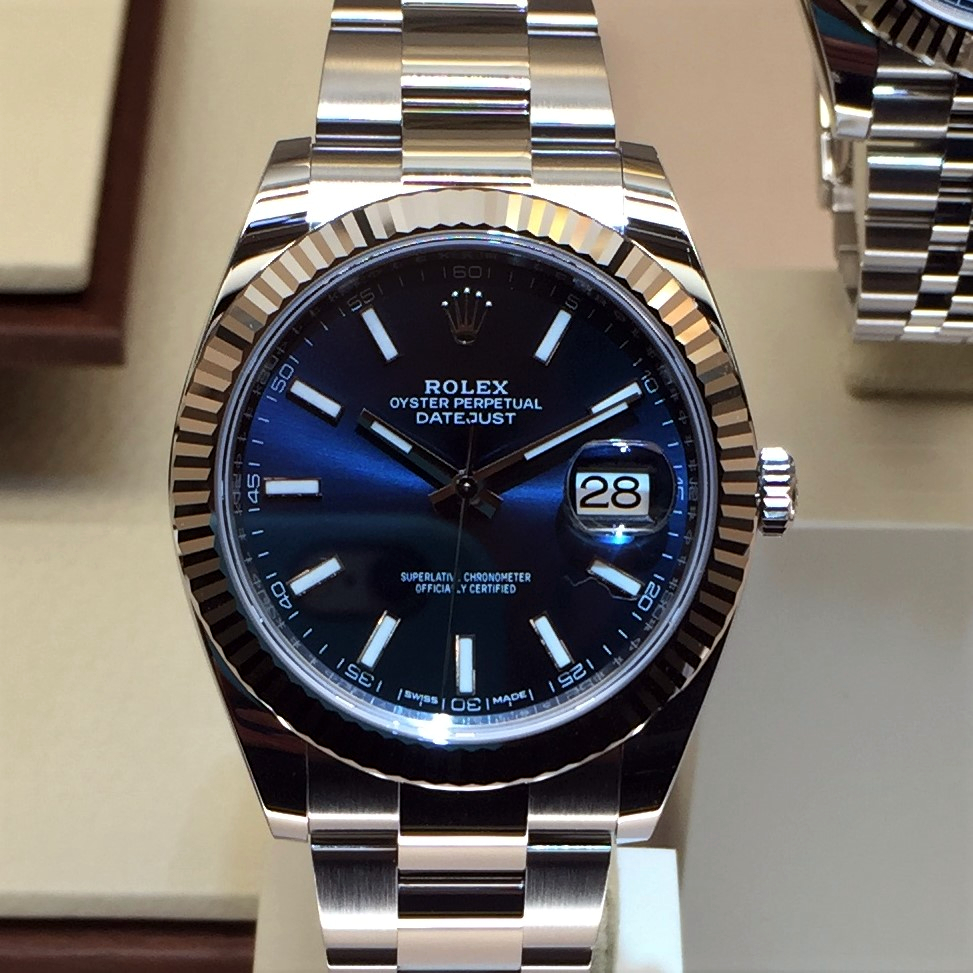
Rolex Datejust 126334, with date display at 3 o’clock and Cyclops magnifier lens
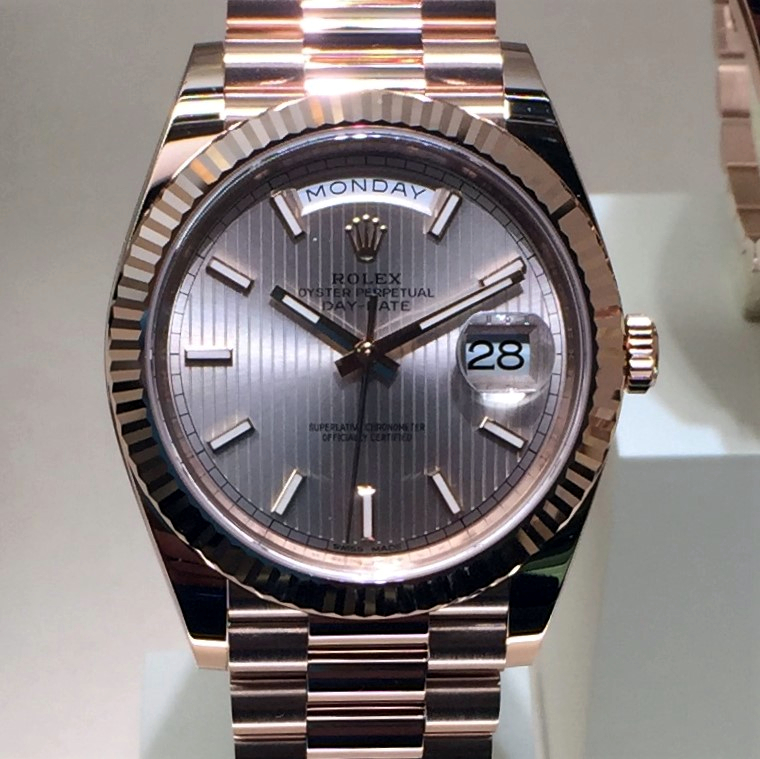
Rolex Day-Date 228235 with day display at 12 o’clock in addition to the date and Cyclops lens
Grande Date Displays
One of the issues with a date being displayed in either a window showing a part of a date wheel or by a pointer is that the numbers are necessarily quite small and can be difficult to read (indeed this is the reason that the Cyclops lens was eventually added to Rolex designs, as founder Hans Wilsdorf’s wife was having difficulty reading the date).
One alternative type of date complication is the grande date, or big date, which as the name suggests provides an indication of the date in a larger or over-size form.
Rather than having a single date wheel with the numbers 1 to 31 on, the grande date splits this into two smaller, separate wheels which allows each to be adorned with larger numbers. The first displays a blank space alongside the numbers 1, 2 and 3, and the second larger wheel displays the numbers 0 up to 9. Placed next to each other, these can combine to display any date – for instance, ‘blank’ plus ‘3’ would be 3rd of the month, ‘1’ plus ‘8’ would be the 18th and so on. The mechanism therefore just needs to make ‘31’ the maximum number displayed before cycling back to display ‘blank’ plus ‘1’, skipping over 32 to 39!
The grande date complication is widely used, but is perhaps most synonymous with A. Lange & Söhne who employ the complication for almost every timepiece they produce with a date indication such as this beautiful Lange 1:
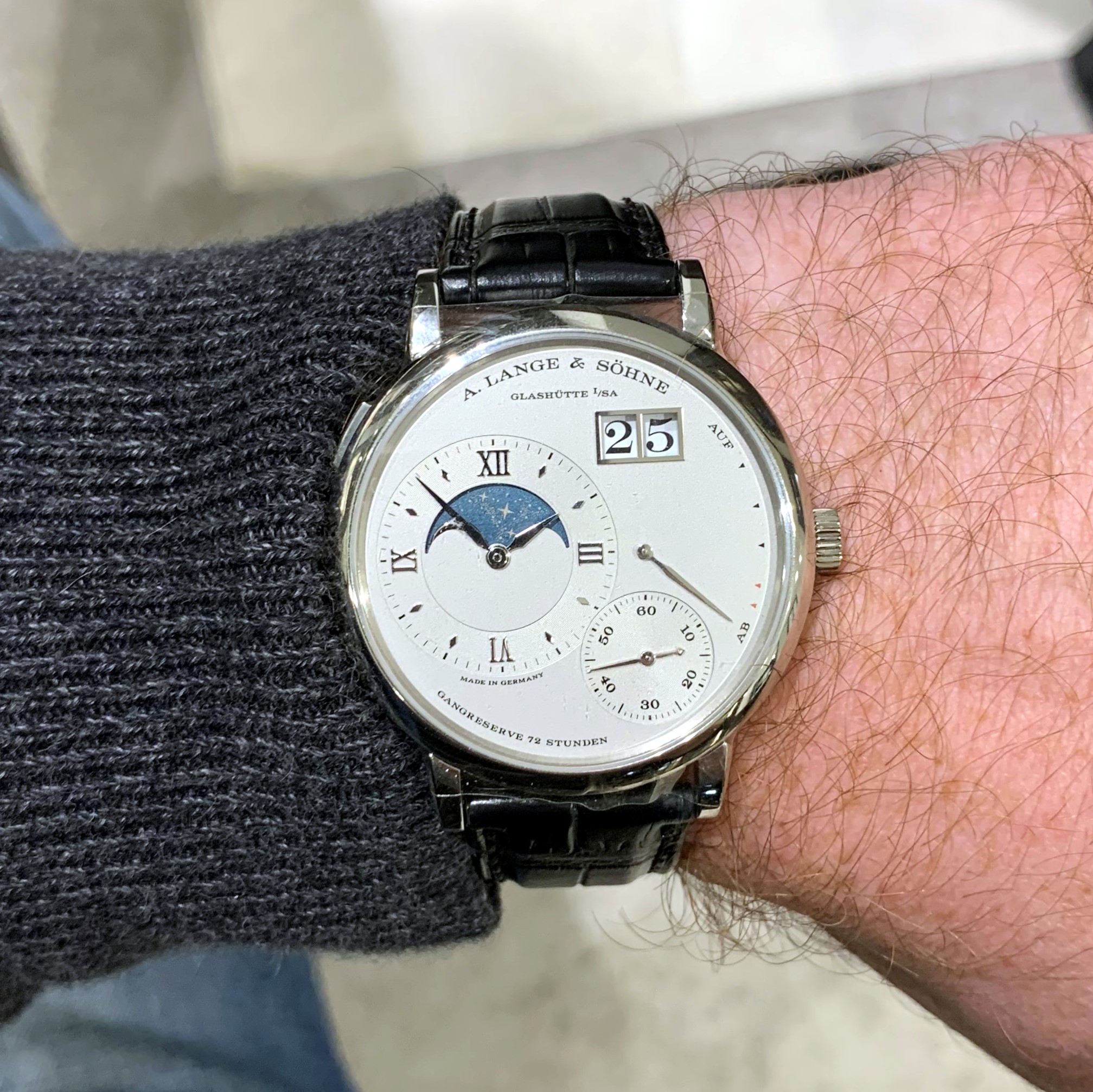
A. Lange & Söhne Lange 1 139.025 with grande date complication at 1 o’clock
Building up from the date and the day of the week, we can start to introduce further complications in the form of calendars. It is interesting to note that as the complexity of the date complications increases, they are increasingly found with a moon phase complication incorporated into the piece as well. There are varying degrees of complexity with calendar complications, depending on how much manual intervention they require to continue to display the correct information, assuming they are kept wound.
Complete Calendar Complications
The complete calendar complication displays the day, date and month but requires manual adjustment when a month is not 31 days long – that is to say that the day following the last day of February, April, June, September and November, the display will incorrectly display the date as 31st instead of 1st, and so will require manual adjustment to advance the complication one position or more than one in the case of February.
Annual Calendar Complications
The annual calendar complication again displays the day, date and month, so all the same indications, however the difference is within the movement. An annual calendar requires manual adjustment only once per year in February – with an annual calendar the date adjustments required at the end of all other months are completed automatically and no manual adjustment is required other than for February.
Perpetual Calendar Complications
The perpetual calendar complication is the pinnacle of calendar complications displaying the day, date, month, and an additional leap year indication. It automatically completes the adjustments required at the end of every month, including February, even so far as adjusting for leap years when an additional day is added to February once every four years. The only adjustment required is when a year which might otherwise be a leap year is not, which will next occur in 2100. We have written a more in depth article on the perpetual calendar, which is available here.
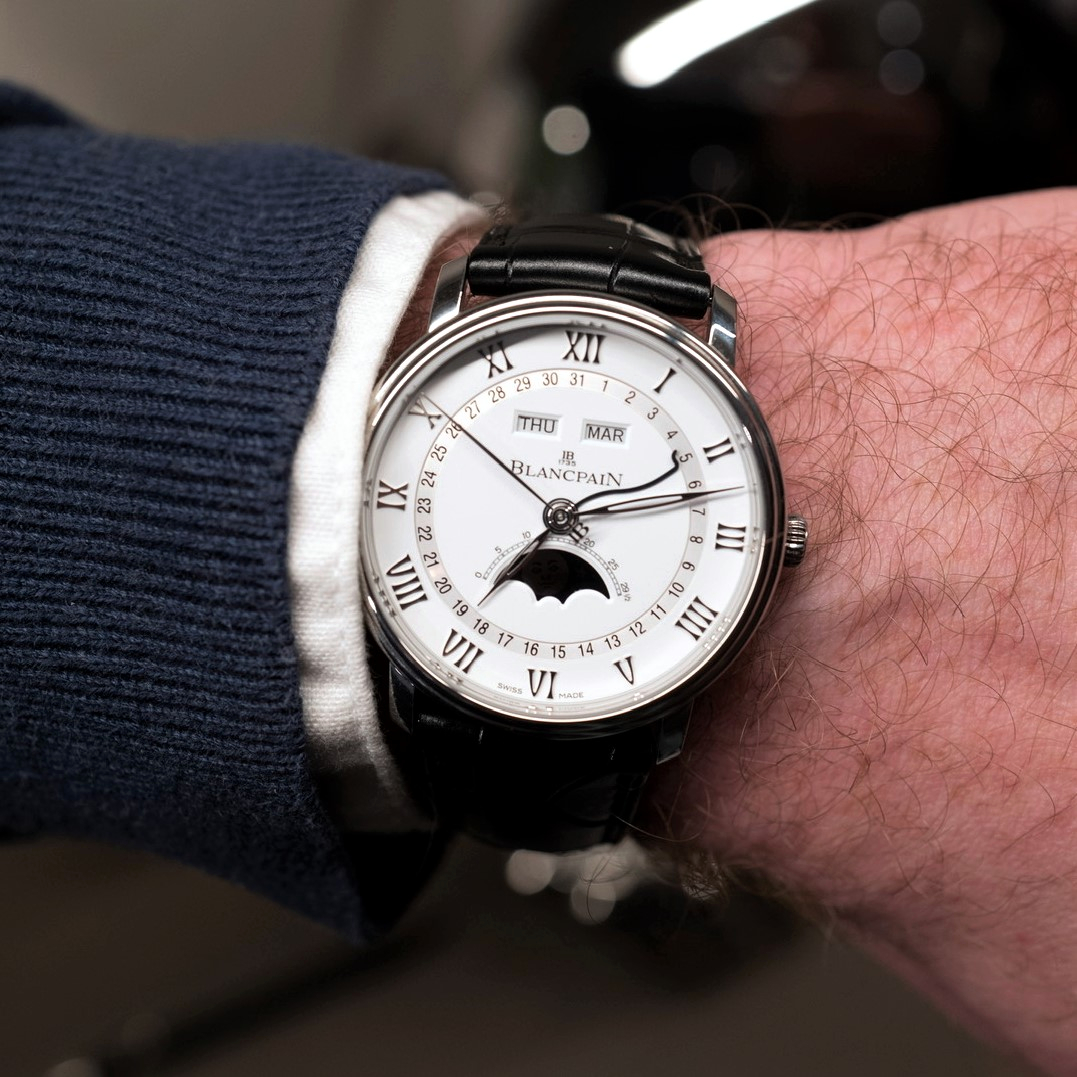
Blancpain Villeret Complete Calendar 6654A 1127 55B with date pointer, day and month apertures at 12 o’clock, and moon phase
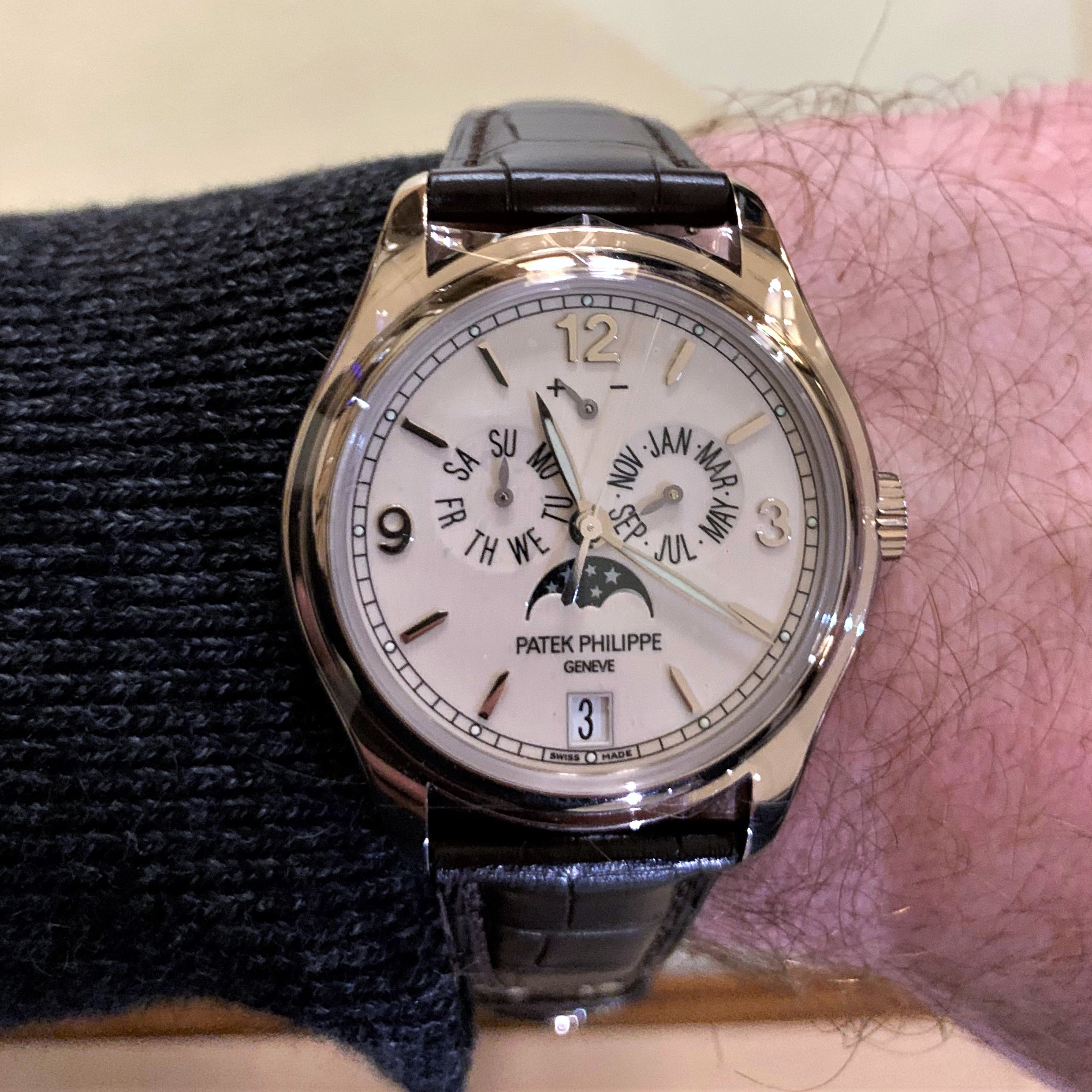
Patek Philippe 5146G-001 Annual Calendar with date aperture at 6 o’clock, day and month point indicators at 9 and 3 o’clock respectively, and moon phase
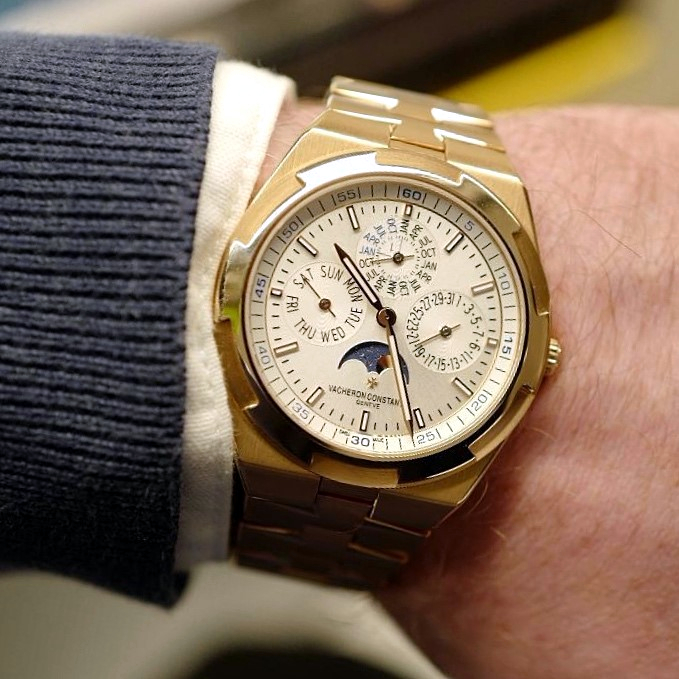
Vacheron Constantin Overseas Perpetual Calendar 4300V/120R-B064 with day, date, month and leap year indications all indicated by hands and no apertures, with a moon phase
Whilst a timepiece with the date can prove to be exceptionally useful, even in the modern era, it can sometimes still be a somewhat polarising complication for some. Sometimes the way in which the complication is implemented can look somewhat unappealing.
For instance, a date window is often included at 3 o’clock such that it can be discreetly read when a watch is under a cuff, or sometimes it is placed between the 4 and 5 o’clock markers. The result of this can be an asymmetrical dial which, for some, upsets the aesthetic balance of a watch. Additionally, the colour of the date window can sometimes make it stand out on the dial if it is different to the main dial colour, which can have a similar detrimental effect on the dial aesthetics. The inclusion of a Cyclops lens over a date aperture can also have a polarising effect, with some people (and I count myself here) finding them altogether unattractive.
One thing is for sure however – with such a wide variety of designs and styles available today, there is all but certainly going to be something for everyone! If you have any questions, or want to share your thoughts, please get in touch via our Contact page, or via our Instagram.
You might also be interested in:
- “It’s complicated”: an introduction to GMT/Travel/Worldtimer Watches
- “It’s complicated” Part 2: an introduction to the Perpetual Calendar
- “It’s complicated”: an introduction to the Chronograph
- Watch Stationery and Gift Ideas
- Watch Books, Watch Boxes and more at the Watch Affinity Shop on Amazon (commissions earned)
As an Amazon Associate, I earn from qualifying purchases – thank you for your support

